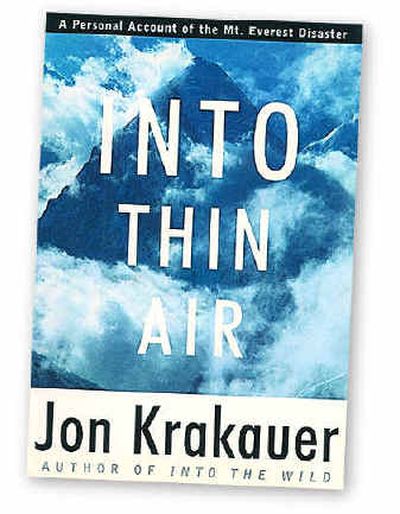‘Into Thin Air’ book selection for December

The closest most of us will ever get to the summit of Mount Everest is in our fantasies.
Jon Krakauer is just the kind of writer who fuels such daydreams. Difference is, the kinds of imaginings that Krakauer evokes in his book “Into Thin Air” are less fantastic than nightmarish.
First told as a 1996 Outside magazine article, then stretched to book length a year later, the story that Krakauer relates concerns his experiences during a disastrous day on Everest that saw eight people die and changed the lives of those who survived. Including and especially Krakauer.
“Everest has turned my life upside down.” Krakauer said in a 1997 interview with Outside magazine, citing questions that keep him awake at night. “Nothing will ever be the same. Why did I end up climbing the mountain on that particular day, with those particular people? Why did I survive while others died?”
As a light dusting of snow colors the Inland Northwest white, it seems only appropriate that “Into Thin Air” (Anchor, 368 pages, $13.95) should be the December read of The Spokesman-Review Book Club. There’s something about the cold that gives a convincing feel to narrations about life at great heights.
And Krakauer’s book is no ordinary adventure narrative. A climber himself, the Seattle author manages to write authoritatively about an incident that, even by Everest standards, is still considered to be one of the worst ever to affect the climbing community.
There were 30 climbers on the mountain that May 10, 1996, when a sudden storm with 90 mph winds caused the temperature to drop to as low as 40 degrees below zero. Because of a series of controversial decisions made by expedition guides, many of the climbers were still on or near the summit late in the afternoon, long after they should have started down.
Part of the criticism later thrown at the expedition leaders involved their apparent willingness to sacrifice safety to keep their clients happy – clients, who by the way, were paying as much as $65,000 a head for the experience.
Krakauer, though, says he was less interested in pointing fingers than in explaining how such a disaster could happen.
“I wanted more than anything else to show the complexities and ambiguities of this tragedy,” he told the Web-based literary magazine Boldtype. “That it’s not simple, and it’s not easy to assign blame, and it’s rooted not in greed and the crassness of thrill-seeking or trophy hunting, but it’s much deeper and more profound.”
Krakauer reached the summit of Everest at 1:17 p.m., which put him in good position to get down in good weather. But he ran into the remnants of three different expeditions still in the process of ascending.
“Thirty feet below, some 20 people were queued up at the base of the Step,” Krakauer wrote, “and three climbers were hauling themselves up the rope that I was attempting to descend. I had no choice but to unclip from the line and step aside.”
Krakauer eventually was able to continue his descent. But before long, the seemingly “innocuous, wispy, insubstantial” clouds that he saw drifting toward him would become a killer storm.
If all “Into Thin Air” offered were a look at disaster, it still would be worth reading. But Krakauer builds up to the moment, capturing not only the days and weeks leading to the deadly day but also the distressing aftereffects. He both captures the characters of his fellow climbers, some of whom would become friends, and documents the harsh effects that life in the Himalayan heights had on his body: sleeplessness, loss of appetite, coughing spells so insistent that they caused him to separate a couple of ribs.
The acclaim that subsequently came his way was nearly universal.
“At the summit, the pressures of the guide-client relationship were immense, even overwhelming the imperative to flee the storm that overwhelmed the victims,” wrote a reviewer for the literary trade journal Booklist. “Krakauer’s eyewitness to the unfolding tragedy makes a transfixing drama of hubris, responsibility, and sacrificial heroism, which will mark the memory of all who read it.”
“This is a great book, among the best ever on mountaineering,” trumpeted the Washington Post, which further praised Krakauer’s book for being “gracefully and efficiently written, carefully researched, and actually lived by its narrator. “
The Wall Street Journal was even more pointed: ” ‘Into Thin Air’ ranks among the great adventure books of all time.”
There have been other books written about the incident, most notably “The Climb: Tragic Ambitions on Everest” by Anatoli Boukreev and G. Weston Dewalt (St. Martin’s Press, 1998). The Russian Boukreev, who died in a 1997 Himalayan fall, disputed Krakauer’s criticism of his actions on the mountain (climbing without oxygen, heading down before clients). To be fair, Krakauer has always praised Boukreev for heading back into the storm and ultimately pulling two people to safety.
The Web is filled with charges that, even now, are traded by one side or another.
But whatever his criticism of others, Krakauer has been equally hard on himself. Even though he’s continued to climb after the incident – though never again, he says, will he attempt Everest – he still feels the burden of guilt typically felt by those who survive deadly events.
“Time collapses as, minute-by-minute, Krakauer rivetingly and movingly chronicles what ensued, much of which is near agony to read,” wrote a reviewer for the book-review journal Kirkus. “Unjustly, Krakauer holds himself culpable for aspects of the disaster, but this book will serve an important purpose if it gives even one person pause before tackling Everest.”